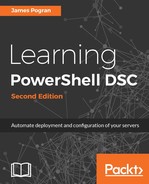After authoring the configuration files and compiling them into MOF files, the next step is the staging phase. This phase slightly varies if you are using a push or pull model of deployment.
When using the push model, the MOF files are pushed to the target node and executed immediately. There isn't much staging with push, as the whole point is to be interactive and immediate. In PowerShell V4, if a target node is managed by a DSC pull server, you cannot push the MOF file to it using the Start-DscConfiguration cmdlet. In PowerShell V4, a target node is either managed by a DSC pull server or not. This distinction is somewhat blurred in PowerShell V5, as a new DSC mode allows a target node to both be managed by a DSC pull server and have MOF files pushed to it.
When using the pull model, the MOF files are pushed to the DSC pull server by the user and then pulled down to target nodes by DSC agents. Because the local LCMs on each target node pull the MOF when they hit the correct interval, MOF files are not immediately processed and thus are staged. They are processed only when the LCM pulls the MOF from the pull server. When attached to a pull server, the LCM performs other actions to stage or prepare the target node. The LCM will request all the required DSC resources from the pull server in order to execute the MOF in the next phase.
Whatever process the MOF file uses to get to the target node, the LCM processes the MOF file by naming it the pending.mof file and placing it inside the $env:systemRoot/system32/configuration path. If there was an existing MOF file executed earlier, it takes that file and renames it the previous.mof file.
